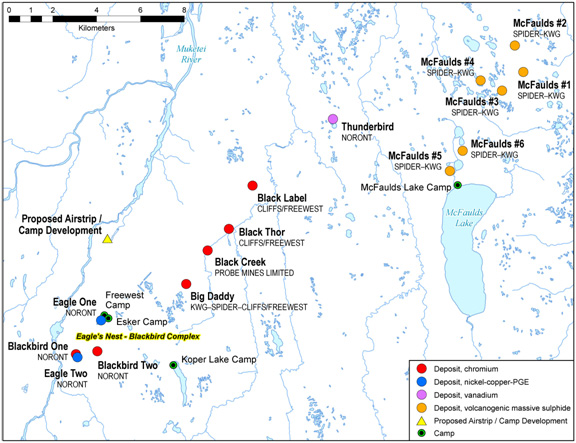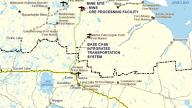In Ontario, planning is slowly advancing for what outgoing Premier Dalton McGuinty referred to as ‘the most significant mining development in Canada in a century’ and what provincial Conservative Leader Tim Hudak referred to as Ontario’s “oil sands”.
Dubbed the “Ring of Fire” by junior exploration companies, the discovery of extensive chromite deposits along with nickel and copper near McFaulds Lake and the Attawapiskat River have raised the possibility of a large and relatively long-lived development (in mining terms) in a remote area on the fringe of the Hudson Bay Lowlands. The area is currently only accessible by air, while winter roads service the surrounding First Nation communities for a few months every winter. In order for the projects to be viable, a massive infrastructure project is being contemplated. The plans of one of the proponents, Cliffs Natural Resources, include a processing facility near Sudbury that would turn chromite into ferrochrome, which is in turn used to make stainless steel.
There are a number of exceptional circumstances surrounding the Ring of Fire developments:
- The potential for multiple projects to be developed – and cumulative effects;
- Effects on the rights and interests of multiple First Nations;
- The region’s remoteness and the need for extensive new infrastructure;
- Environmental sensitivities including a landscape with more water than solid ground and important habitat for “threatened” caribou;
- Mining and processing chromite, which has the potential to be highly toxic, for the first time in Canada.
- Massive energy demand from proposed ferrochrome facility, equivalent to a city of 350,000.
Given these and other complexities, MiningWatch has been advocating a regional strategic review of development in the area through a joint federal-provincial review panel. Our call echoed the demands of affected First Nations, other NGOs and even civil servants in the federal government. We were, however, told by a representative of Cliffs Chromite that they were looking for a one-off review through what the federal environmental assessment process used to call a Comprehensive Study. Apparently their consultants told them this was the best way to harmonize the federal and provincial reviews. It’s also faster, avoids the scrutiny of public hearings, and based on past reviews even less likely to turn down a project than a review panel.
So far the reasonable demand for a regional review panel has been ignored. Cliffs and a small junior company, Noront, are undergoing separate federal environmental assessments, and each has volunteered to do a separate but harmonized assessment under the provincial environmental assessment process.[1] Matawa First Nations, a tribal council representing many of the affected First Nations, launched a request for a judicial review over the decision to not do a joint review panel. A hearing on the merits of the case is being delayed by procedural objections from Canada and Cliffs, who have moved to strike some of the expert evidence. The proceedings will begin again in January 2013. In the meantime, the Chiefs continue to call for political action to ensure that there is a rigorous review of the project, with meaningful First Nations consultation.
While a joint process would have allowed for a single environmental assessment with one round of consultations on the terms of reference, then on the environmental impact statement (EIS), and finally comments to a panel, those involved in the process are now having to juggle making submissions to two distinct but supposedly harmonized processes. The federal guidelines and provincial terms of reference were presented for public review earlier this year with the federal guidelines now finalised.
In May, the Ontario government shocked many observers by making a joint announcement with Cliffs about the province’s plan to support infrastructure development for the Ring of Fire. First Nations were alerted about the announcement shortly beforehand but were not consulted about the content of the announcement. This seemed to put Ontario on the side of one of the proponents (Cliffs) and its preferred access route. Noront has proposed another route, which, though longer, makes greater use of existing infrastructure and has greater potential to provide access to fly-in and winter-road-accessible communities. The press conference gave the impression that Cliffs was in the driver’s seat on the road to the Ring of Fire, with Ontario just a passenger along for the ride.[2] The province’s endorsement and commitment to subsidize the infrastructure for the project ahead of an environmental assessment or any other publicly-disclosed analysis was deeply troubling. MiningWatch was well positioned to respond and we were quoted extensively in an article in the Toronto Star.[3]
Over the summer, Neskantaga First Nation has been particularly vocal about their concerns with how developments are unfolding. In response to the joint Ontario-Cliffs announcement in May, Chief Peter Moonias emphatically stated that a mining road would cross over the Attawapiskat River only over his dead body.[4] Since then the First Nation has also documented an important archaeological site at the approximate location of the crossing. Neskantaga also made their concerns known in a case before the Ontario Mining and Lands Commissioner between Cliffs and another company, KWG.
The smaller junior company, KWG, had pre-emptively (and in our view inappropriately) staked the land where Cliffs wants to build a road – a long glacial deposit that snakes along in a north-south direction and is pretty much the only solid ground in the area.[5] KWG staked the claims in the hopes of building a railway. Neskantaga argued before the Commissioner that decisions over access and rights to their traditional territory shouldn’t be left to a hearing between two mining companies. The Commissioner’s response was sympathetic, acknowledging a lack of consultation with Neskantaga over the road corridor, but also indicating that it was not her mandate to ensure meaningful consultation as she only had the mandate to address the immediate issue between the two companies.[6]
One of the other commitments the Ontario government made back in May was to develop a regional monitoring program. While not a replacement for a pre-development regional planning process, a regional monitoring program, if well designed and well implemented, and with adequate regulatory and political teeth, would be a crucial element of responsible development in the region. To date there are no details about how the monitoring program would operate, but the government has been conducting research on other initiatives across Canada. It is not clear if the resulting report will be made public.[7] Were it to be made public, it would be a first. To date Ontario has offered no substantive research or policy documents. The Ministry of Northern Development and Mines has some very basic information and commitments posted on its Ring of Fire website.
One of these commitments is to “work with those First Nation communities most proximate to Ring of Fire development to negotiate a specific share, equivalent to a portion of the province’s resource revenues associated with new mines in the Ring of Fire region.”[8] While this commitment goes some distance to addressing the demands of First Nations to share the economic benefits of developments on their traditional territories, the statement raises two concerns. Firstly, compensation to affected communities should be based on potential or actual impacts, and some communities distant from the area but downstream may be affected. Also, one wonders how transparent the Province will be about the revenues they stand to get from new mines in the Ring of Fire. With a 10-year remote mine tax holiday and then a meagre 5% remote mine royalty on profits, with the ability to hold-over all manner of exploration and development expenses indefinitely, it may well be decades before these operations start paying Mining Tax or corporate taxes.
As of the date of this publication, the latest news from the Ring of Fire is that Cliffs has indicated it may push back its targeted production date by a year[9]. Despite all the rhetoric from our governments (especially the federal government) about the need to streamline review processes, this is an excellent example of how many delays in project development have little to do with review processes themselves and everything to do with a proponent’s ability to plan and finance a project in ever-changing circumstances.
We are becoming increasingly concerned that Ontario is letting the companies, Cliffs in particular, set the agenda for development in the Ring of Fire. Given the expectation of significant public subsidies, Ontario should step up and start providing better information to the public and get serious about relating to the First Nations in a respectful nation-to-nation manner. Looking ahead, MiningWatch will continue to play a role advocating for more thorough review process and filling information gaps. Our fact sheets on chromite have been very well circulated and well received. The Ontario Ministry of the Environment even requested a copy of the full literature review – which is now posted on our web site. We are also working with other NGOs and First Nations to increase accountability and shift the province into a more proactive role that puts public interest at the core of government decision-making.
[1] Ontario is the only jurisdiction in Canada where a major mine development is not automatically subject to the provincial/territorial environmental assessment process. Volunteering for a review gives a company the opportunity to avoid public consultation on more detailed permitting processes after the EA is approved.
[3] Our reaction to the press releases from Cliffs and Ontario is here, and the Toronto Star article is here: http://www.thestar.com/business/article/1176547--chromite-mine-may-carry-hidden-costs-critics-charge
[4] Chief Peter Moonias, Why I Will Defend the Attawapiskat River, from a speech reprinted in the Wawatay News http://www.wawataynews.ca/archive/all/2012/6/21/why-i-will-defend-attawapiskat-river_22993
[6] Mining and Lands Commissioner, http://www.web2.mnr.gov.on.ca/mnr/omlc/CanadChromeOrderOnPartyStatusAug24-2012.html
[7] Information from a presentation made by Ring of Fire Secretariat Senior Policy Advisor Ariane Heisey at the Ontario Association for Impact Assessment, October 23, 2012.
[8] Ontario Ministry of Northern Development and Mines, http://www.mndm.gov.on.ca/en/ring-fire-secretariat/first-nations-partnerships

